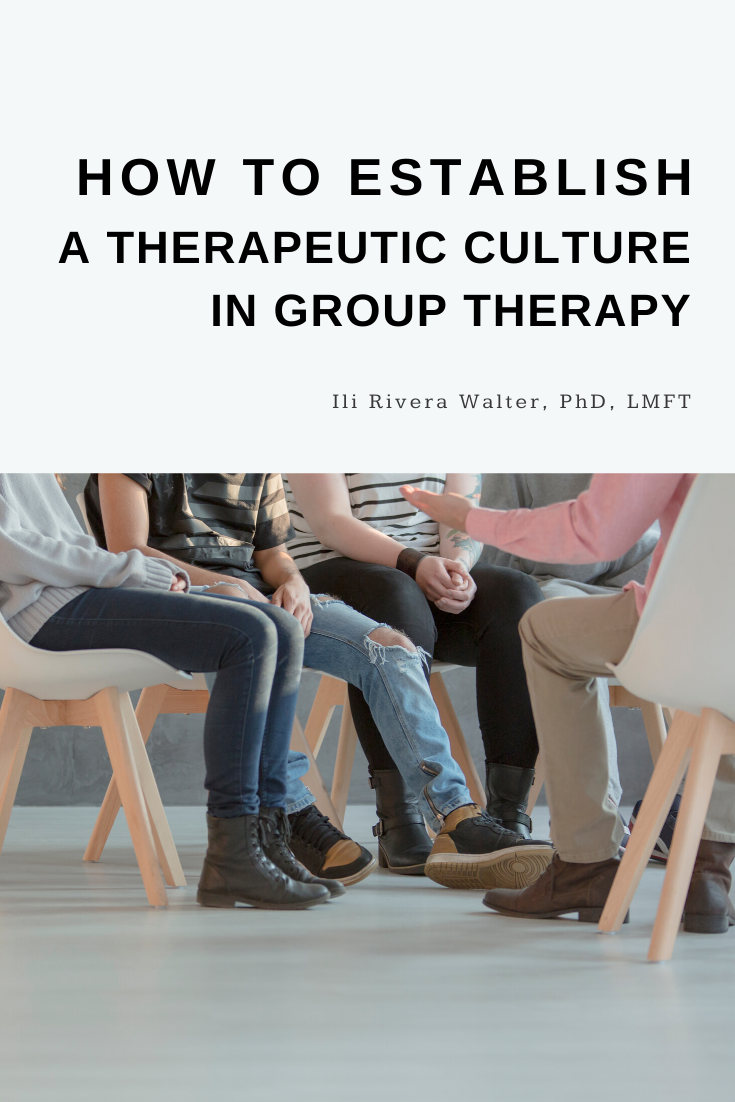This post was originally published on September 26, 2017, and was updated on November 9, 2019.
One of the main roles of a group therapist is establishing the group's culture. Group culture is influenced by the group's structure (i.e., a closed vs. an open group), meeting schedule, and explicit and implicit rules. Both group members and therapist contribute to the culture over time; however, the therapist plays the lead role in setting both the tone and structure of the group.
Similar to family therapy, group therapy allows both the therapist and members to participate in and observe interpersonal dynamics, and therefore presents opportunities for relating differently in the moment. Like individual therapy, client self-disclosure and reflection are essential in group therapy; although, unlike individual therapy, these take part within a relational system--the group.
In this post, I offer tips for how you can establish and maintain a therapeutic culture in group therapy. This post is written for a closed group design; however, the information is also applicable to open groups.
Practical Responsibilities
As a group facilitator, your first responsibility is to engage the members of the group in some level of conversation, and ensure that they return and remain for the length of the group. This is an ongoing task that relates to the way each member experiences you, as well as the group as a whole.
Group members learn not only from other group members, but also from the therapist's relational habits, including invitation to conversation, boundary setting, therapeutic transparency, facilitation style, among other factors. The group therapist is a role model, much like a teacher or mentor.
For example, as a new graduate student, I remember one of my professors apologizing to our class for his lateness in grading our course work. He did not return our work until the end of the semester. While he took responsibility, he also explained that he would rather have time to prepare for classes and engage with us as a supervisor than return our written work in a more timely manner. By providing this explanation, he taught us that we have choices to make, and that we will "fall short" sometimes. He also showed that it is acceptable and caring to communicate failings, while in a leadership role, to those whom we are accountable. This was one of my first lessons in publicly taking responsibility, and I have never forgotten it.
In group therapy (and in all therapy) the way we facilitate reveals new relational options to clients.
Therapist Posture
The therapist's posture towards group members must be one of unconditional positive regard--that is, accepting people as they are, including their group contribution and their choices inside and outside of group. Rogers explains, "People are just as wonderful as sunsets if you let them be. When I look at a sunset, I don't find myself saying, 'Soften the orange a bit on the right hand corner.' I don't try to control a sunset. I watch with awe as it unfolds." The group is not only the setting for the the person to unfold, it is also the method.
The Agent of Change
If the therapist is the group organizer, then initially, the therapist is the only connection individual members have to the group. The therapist serves as an initial unifying force (Rogers, 1965); however, over time, members become unified and are motivated to participate because of their joint investment.
In group therapy, like in couple and family therapy, it is individual clients and their larger relationship within therapy that is the agent of change. Yalom (1995) summarizes: "It is the group members who, in their interactions, set into motion the many therapeutic factors, then it is the group therapists's task to create a group culture maximally conducive to effective group interaction" (pp. 109-110).
How can group therapists create this type of culture?
Establish Rules/Norms
Group norms include rules of conduct, group and member goals, expectations and responsibilities of members, among others. Naturally, some group norms are established over time, implicitly, based on unspoken expectations and habits that form inside the group. While many of these may not be harmful to the group's culture, including explicit norms allows the therapist and group members to begin and continue the group with a sense of ownership and understanding about the group's purpose and process.
Group culture is, therefore, influenced by a balance of the explicit and the implicit. Here are some ideas for contributing to an open, safe group culture, while embracing the therapist's position as role model:
In the first group session:
Orient members to the group as you would clients in individual therapy. Some members may be in group for the first time, and others may be group therapy veterans. Regardless, this group is a unique relational system that requires members to find their way, anew.
Invite group members to collaborate on a shared vision for the group as well as for themselves as members of the group. During this conversation, the group therapist serves as facilitator and documenter of the group's ideas.
As the group continues:
Allow members to participate at their own pace. This creates an environment of safety and acceptance.
Use affirming, empathic statements, rather than probing questions. Comment on what the members have done well during group, rather than what is lacking in their participation. A shift from questions to empathic statements may be a challenge for marriage and family therapists, in particular, but it has its usefulness for creating a safe space, especially during the group’s beginning stage.
Highlight group process. For example, when you see commonality between participants: "It sounds like the two of you have had similar experiences."
Communicate, consistently, group members' responsibility to the group. For example, if a member complains about the direction of the conversation, the question "What would you like to discuss?" invites clarity for the participant, and allows group members to prioritize and choose topics.
Ask group members to evaluate their experience on a regular basis. For example, "How has the group been helpful today?", and/or "With what aspect of the group are you satisfied, or dissatisfied?" The purpose of these questions is not for the therapist to take ownership of group members' satisfaction, but rather to invite ongoing conversation between members about spending group time on what is meaningful to them.
Orient to the present
The most therapeutic potential in group therapy is found in what is happening right now, rather than what has happened or is happenning outside of group. Group members experience each other in particular ways, and group therapists must highlight these experiences for group members, so that they begin to gain an awareness of interactional dynamics (Rogers, 1965). This awareness initiates reflection, which contributes to continued participation in the group, additional therapeutic moments, and so forth.
How are members relating to one another?
What is therapeutic and valuable (in terms of process) in their responses to one another?
What are they self-disclosing?
How are they reacting to each other's stories and emotions?
Are they communicating ownership and personal application of what they hear in group?
Do they feel validated?
Group therapists can can answer these questions by observing the interactions between members of the group. By maintaining their focus on the present--what is happening in the here and now--group therapists cultivate a therapeutic culture.
Oftentimes, this orientation to the here and now is only possible by avoiding intervention in favor of observation, as well as responding with affirmation and curiosity rather than techniques. The group therapists are in a specific role within the group and are always joining and establishing trust—not only between themselves and members, but also between members. This trust can be nurtured by:
Believing clients can and will make steps toward their goals
Highlighting therapeutic moments that occur between members, as well as therapeutic "nuggets" that are communicated in the meeting
Responding to each member with acceptance and care
Managing the emotions of all members in ways that invite continued self-disclosure and participation
Communicating acceptance, nonverbally, with members that are reserved or don't speak often in group conversations
Resisting the pressure to influence members' frequency or type of participation
Group therapists constantly consider what the group needs most, right now, to keep it moving in a particular, therapeutic, direction (Yalom, 1995).
Resources
The article, The Evolution of Circular Questions: Training Family Therapists, includes examples of questions that highlight interactional processes. They can be utilized within group therapy, although the article was originally written for family therapy scenarios.
This comprehensive guide on group therapy, from PositivePsychology.com, includes activities, worksheets, and information on a variety of group therapy topics.
References
Rogers, C. R. (1965). Client-centered therapy. Houghton Mifflin: Boston, MA.
Yalom, I. D. (1995). The theory and practice of group psychotherapy (4th ed.). New York, NY: Basic Books.
Let's Chat
What is your number one struggle as a group therapist?
What do you enjoy most about facilitating groups?
* Amazon links included in this post are affiliate links.













